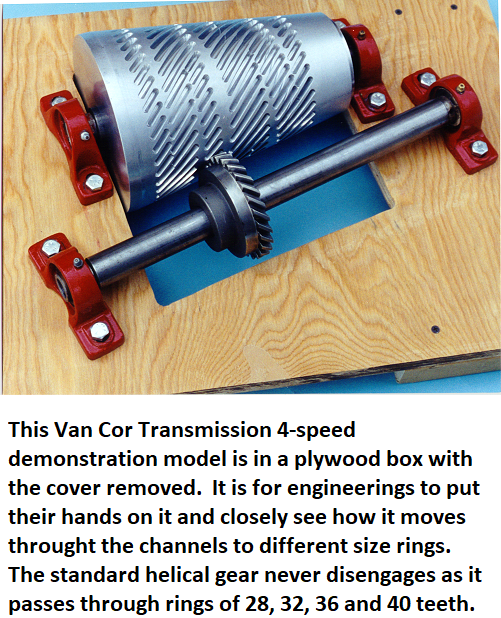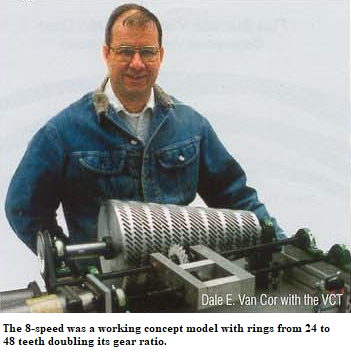Van Cor Transmission 2002
Dale E. Van Cor
last updated 11/27/2020


Dale E. Van Cor
last updated 11/27/2020


This is a history of my experiences prior to 2006 at developing ideas from concerts, to engineering software and models, to patents.
My first was the Van Cor Transmission or VCT, followed by spin offs of the VCT and additional concepts.
The invention in the VCT are rings of gears cut on a cone and connected by channels of transition teeth. The conic
gears are based on mathematics that allows the teeth to run at a constant speed while the surface velocity of the cone differs at every radii.
The channels of transition teeth fractionally change the gear ratio between the conic gears. An acceleration channel increases to the gear ratio
of the next larger ring while the deceleration channel decreases the gear ratio to that of the smaller ring.
The VCT software was developed to engineer rings of conic gears that were then assembled into a transmission system connected by channels of fractional
transition teeth. That software would take a computer model and generate 5-axis Gcode to cut all the involute profile teeth. The fifth axis was
fixed so a sign plate was used with a 4-axis machining.
Of the 640 US gear and transmission companies I wrote to, 200 I called and 5 I visited there are three problems with the VCT. The 3D teeth can not
be cut with the 2D gear shaving manufacturing method that everybody uses; it will cost tens of millions of dollars to develop the engineering capacity
to design applications; and the movement for changing its gear speeds through the channels in one rotation is limiting.
VCT had a US, Taiwan, EPO and PCT international patents with 43 claims. It had a 100 drawings and 49 pages of text. A detailed description
of the technology can be found at this document link.
VCT2 friction Tooth had a US patent with 39 claims. Its detailed description is at this document link.
VCT3 variable chain/tooth belt was on the drawing board. Details are at this document link..
VCT4 variable worm drive was a concept only and concluded it was not worth pursuing.
VCT5 fractional tooth turned out to be impossible, but that had extensive software modeling to discover that. The upside was the learning curve of how and why the VCT7 would work.
VCT6 acceleration coupling was concept only and it was for reducing the size of electric motors. They are chosen by the amount of starting
torque needed. The VCT6 would start at a gear reduction of 1:4 and accelerate to 1:1 thus requiring a smaller motor.
VCT7 was a breakthrough concept. A true CVT that continuously balanced the output gear ratio with the input torque against the output load.
It would take at least 1,000 hours to get a concept model. This has entirely different teeth.
Other work:
When I saw a US military tank in Iraq that was stuck waiting for help with two other tanks providing protection, I had this idea: a spool of wire
attached to the drive gear of the tract of a second tank. Then, as the second tank drove ahead 100 feet the spool of wire unwound 90
feet pulling the stuck tank 10 feet. That is a gear reduction of 10:1. If the tanks have to leave quickly, the spool of wire can be quickly
discarded. This concept is only practical for tracked vehicles because of the high friction needed. An engineering model was built and tested; and patent issued.
The Army was not interested. A detailed description is at this document link..
I built a test model of a fluid separation idea that separated dissolved matierals without boiling. The machine was twelve feet in diameter, eight foot high and powered
by two electric motors. It was built in my neighbors barn because he had a cement floor and my barn was a dirt floor. Salt water was used as the testing medium in 144 tests.
In the last 100 tests, 7%-14% reduction in salt was common. Some were in the 20s and one at 35%. That high one was not repeated so it is not included. The testing was for
changes in electrical resistance relative to the percent of salt. Every 10th test was boiled down to weigh the remaining salt and confirm the electrical test results.
The VCT Conic Gear lead me to the Conic thread, one of the four mechanical Van Cor Threads that have high surface contact. I wrote most of the six patents, three have
been issued. I developed four software systems that output 3D print files for threaded parts. The destructively testing of wave threaded nuts and bolts
at the University of New Hamnpshire can be found at vancorthreads.com..
Most of the VCT work was funded by my DuVan Software Corp. business. I developed 57 turn key software systems for 28 customers from 1984-2000. The biggest was a distribution
system with PO, recieving, SO, shipping, AR, AP used by 3 people to manage over 5,000 hard goods and date sensitive feed stock. In use for over 20 years. My biggest achievemnet
was a cost modeling system for a 110 employee company with over 200 jobs any time. It cut projection errors by 60%; and was used to quote jobs with up to
38 operations and job runs over 7,000,000. It reduced cost engineering from 40 hrs/week to 8 hrs/week by backing into a knowledge base where most new work
had already been done in some form.